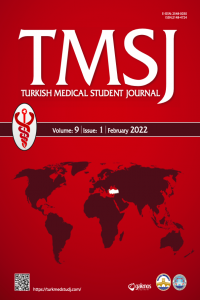IMPACT OF T WAVE AMPLITUDE IN LEAD aVR ON PREDICTING APPROPRIATE THERAPIES IN HYPERTROPHIC CARDIOMYOPATHY PATIENTS WITH AN IMPLANTABLE CARDIOVERTER DEFIBRILLATOR
IMPACT OF T WAVE AMPLITUDE IN LEAD aVR ON PREDICTING APPROPRIATE THERAPIES IN HYPERTROPHIC CARDIOMYOPATHY PATIENTS WITH AN IMPLANTABLE CARDIOVERTER DEFIBRILLATOR
Aims: Although implantable cardioverter defibrillator reduces mortality in hypertrophic cardiomyopathy patients,
inappropriate implantable cardioverter defibrillator shocks are related to increased mortality. The aim of this study
is to investigate whether a new electrocardiographic marker of T wave amplitude in lead aVR can be used to predict
appropriate therapy of implantable cardioverter defibrillator (shock or anti-tachycardia pacing) in hypertrophic cardiomyopathy
patients.
Methods: Thirty-six hypertrophic cardiomyopathy patients, who were admitted to the outpatient clinic for pacemaker
control, with implantable cardioverter defibrillator were retrospectively examined (mean age: 51 ± 10.2 years,
72.2% male). The primary endpoint was appropriate implantable cardioverter defibrillator therapy. All hematological,
biochemical and electrocardiogram parameters were measured before implantable cardioverter defibrillator was
implanted.
Results: Over a median follow-up period of 33 months, 9 (25%) patients experienced appropriate implantable
cardioverter defibrillator therapy. Heart rate and QRS interval were similar between groups. QT and QTc values
were higher in patients that received appropriate shocks. Patients who have T wave inversion were higher in therapy
positive group. T wave amplitude in lead aVR values were significantly associated with appropriate therapy.
Conclusion: Using simple ECG parameters, we may predict arrhythmic episodes before ICD implantation and an
improvement of the medical antiarrhythmic therapy might be protective for HCM patients with ICD.
Keywords:
Hypertrophic, cardiomyopathy, defibrillator, electrocardiography,
___
- 1. Maroon BJ, Maroon MS. Hypertrophic cardiomyopathy. Lancet 2013; 81:242–55.
- 2. Liew AC, Vassiliou VS, Cooper R et al. Hypertrophic cardiomyopathy-past, present and future. J Clin Med 2017;6(12):118.
- 3. Spirito P, Autore C, Formisano F et al. Risk of sudden death and outcome in patients with hypertrophic cardiomyopathy with benign presentation and without risk factors. Am J Cardiol 2014;113:1550-5.
- 4. Veselka J, Zemanek D, Jahnlova D et al. Risk and causes of death in patients after alcohol septal ablation for hypertrophic obstructive cardiomyopathy. Can J Cardiol 2015;31:1245-51.
- 5. Maron BJ, Rowin EJ, Casey SA et al. Hypertrophic cardiomyopathy in adulthood associated with low cardiovascular mortality with contemporary management strategies. J Am Coll Cardiol 2015;65:1915-28.
- 6. Sears SF, Conti JB. Quality of life and psychological functioning of ICD patients. Heart 2002;87:488-93.
- 7. Moss AJ, Schuger C, Beck CA et al. Reduction in inappropriate therapy and mortality through ICD programming. N Engl J Med 2012;367:2275-83.
- 8. Özkartal T, Breitenstein A, Saguner AM et al. The subcutaneous implantable cardioverter defibrillator in daily clinical practice. Swiss Med Wkly 2017 9;147:w14518.
- 9. Konno T, Fujino N, Hayashi K et al. Differences in the diagnostic value of various criteria of negative T waves for hypertrophic cardiomyopathy based on a molecular genetic diagnosis. Clin Sci (Lond) 2007;112(11):577-82.
- 10. Tan SY, Engel G, Myers J et al. The prognostic value of T wave amplitude in lead aVR in males. Ann Noninvasive Electrocardiol 2008;13(2):113-9.
- 11. Kireyev D, Arkhipov MV, Zador ST et al. Clinical utility of aVR-The neglected electrocardiographic lead. Ann Noninvasive Electrocardiol 2010;15(2):175-80.
- 12. Babai Bigi MA, Aslani A, Shahrzad S. aVR sign as a risk factor for life-threatening arrhythmic events in patients with brugada syndrome. Heart Rhythm 2007;4(8):1009-12.
- 13. Matsukane A, Hayashi T, Tanaka Y et al. Usefulness of an upright T-wave in lead aVR for predicting the short-term prognosis of incident hemodialysis patients: a potential tool for screening high-risk hemodialysis patients. Cardiorenal Med 2015;5(4):267–77.
- 14. Tanaka Y, Konno T, Tamura Y et al. Impact of T wave amplitude in lead aVR on predicting cardiac events in ischemic and nonischemic cardiomyopathy patients with an implantable cardioverter defibrillator. Ann Noninvasive Electrocardiol 2017;22:1245-53.
- ISSN: 2148-4724
- Başlangıç: 2014
- Yayıncı: Trakya Üniversitesi
Sayıdaki Diğer Makaleler
PERIOSTEAL CHONDROMA OF THE FEMUR: A CASE REPORT
Ece ŞENYİĞİT, Nur Gülce İŞKAN, Mert ÇİFTDEMİR
Fatih Erkan AKAY, Berfin TAN, Mahmut Alper GÜLDAĞ, Hilal Sena ÇİFCİBAŞI, Kubilay ELMACI, Elif Gülsüm ÜMİT
A CASE REPORT OF SPONTANEOUS CORONARY ARTERY DISSECTION
Yusuf Can ÖZDEMİR, Kubilay ELMACI, Fatih ÖZÇELİK
Vinisha TEKWANİ, Varahabhatla VAMSİ, Gaidai NATALİYA
Begüm SÖYLEYİCİ, Pelinsu Elif HÜNKAR, Çağrı GİRİT, Cansu KURT, Fatih Mehmet UÇAR
